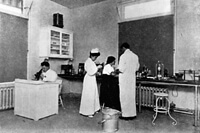Research History (Page 1 of 3)
Through the years, National Jewish Health* has aspired to be much more than a facility simply for the physical treatment of disease.
Over the years, our clinical and translational researchers have made many groundbreaking discoveries.
In the 1940s and 50s, scientists pioneered the development and use of combined chemotherapy treatment for tuberculosis.
In 1960, scientists developed the first clinically useful method of diagnosing asthma.
Our scientists also identified how HIV infects and kills T cells that would normally protect the body from disease invasion.
Early Research Efforts
 In 1919, with the establishment of a research department aimed at discovering a cure for tuberculosis (TB), the institution's career as a significant research facility began. National Jewish was the first hospital to establish a research department separate from clinical laboratories and with a full-time staff and director, Harry J. Corper, MD.
In 1919, with the establishment of a research department aimed at discovering a cure for tuberculosis (TB), the institution's career as a significant research facility began. National Jewish was the first hospital to establish a research department separate from clinical laboratories and with a full-time staff and director, Harry J. Corper, MD.
Dr. Corper’s laboratory contributions included establishing a new method of culturing the TB germ on a simple Irish potato instead of using expensive guinea pigs. This became a standard procedure in TB labs everywhere. Using laboratory studies, Dr. Corper demonstrated that specific immunity is a potent factor in resistance to TB and he discovered, for the first time, that the tubercle bacillus was an incredibly hardy germ – it can remain alive outside the body as long as 30 years, and resists hot and cold extremes that no mammal could survive.
When Gardner Middlebrook, MD succeeded Dr. Corper as head of research in 1951, the commonplace use of drugs began to give a new slant to basic research. (Interestingly, Dr. Middlebrook had developed TB while in medical school, prompting him to devote his career to researching the disease.) Scientists added drug research to their approaches to understanding the characteristics of the tubercle bacillus and other mycobacteria and to investigating how immunity works on TB.
Dr. Middlebrook guided his staff into many studies of isoniazid (INH), a first-line antituberculous medication. He soon demonstrated that each person “inactivates” (metabolizes and eliminates) INH differently. So in order for the drug to be effective against TB, dosages must be determined individually for each patient. If the wrong dosage was used, the patient would quickly become drug-resistant. This led Dr. Middlebrook to develop a method of determining how much of the drug was enough.
NEXT: Expanding Basic Research
Page 1, 2, 3
*Over the years, the National Jewish Health name has evolved to better communicate our mission. However, all names have included a common component –the words National Jewish. Therefore, the name National Jewish is used in all references to our institution throughout this history overview.